This information explains how to give an emergency Solu-Cortef injection (shot). Solu-Cortef is a medication that contains cortisol.
About Cortisol
Cortisol is a hormone that helps:
- Your body heal itself when you’re sick or when you get hurt.
- Maintain your blood pressure and heart function.
- Control your blood sugar levels.
Cortisol is made by your adrenal glands. Your adrenal glands are located above your kidneys.
About Adrenal Insufficiency
Adrenal insufficiency is when your adrenal glands don’t make enough cortisol. If you have adrenal insufficiency, you need to take medication to replace the cortisol every day.
Sometimes, your body will need extra cortisol. This can be when you’re sick or have a serious injury. When you get sick, your healthcare provider will recommend that you double or triple your daily cortisol dose for 3 days until you feel better. Call your healthcare provider if you continue to feel sick.
If you don’t have enough cortisol, your body can go into adrenal crisis. This is when your blood pressure drops very low. When this happens, you’ll have to give yourself an emergency injection of a cortisol medication called Solu-Cortef. Your healthcare provider will give you a prescription for Solu-Cortef.
When To Give Yourself an Emergency Solu-Cortef Shot
Give yourself an emergency injection of Solu-Cortef if you:
- Have a serious injury, such as breaking a bone or losing a lot of blood.
- Are vomiting (throwing up).
- Feel faint or like you’re going to pass out.
- Are too sick to take your daily cortisol medication.
There may be other times when you should give yourself an emergency injection. Follow your healthcare provider’s instructions.
You’ll need to make an emergency injection kit. Make sure your kit is always ready in case you need it. Call your healthcare provider’s office if you have any questions.
Make an Emergency Solu-Cortef Injection Kit
You’ll need to make and maintain an emergency injection kit (see Figure 1). Your emergency injection kit should include:
- A Solu-Cortef Act-O-Vial bottle.
- 2 alcohol wipes.
- A sterile syringe with a needle.
- A gauze pad.
- A bandage (such as a Band-Aid®).
- A disposable sharps container, such as an empty laundry detergent bottle with a screw-on cap. Label the container “Home Sharps – Not for Recycling.”
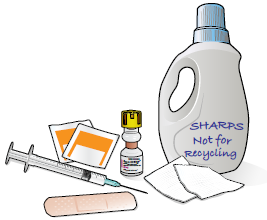
Figure 1. Your emergency injection kit.
How To Give an Emergency Solu-Cortef Shot
Follow the instructions below to give an emergency Solu-Cortef shot.
Your caregiver should also know how to give you a Solu-Cortef injection in case you can’t do it yourself. After practicing in the hospital with your nurse, you and your caregiver should review these instructions together.
Get Ready To Give the Shot
- Open your emergency injection kit and take out all your supplies. Set them on a clean, open surface, such as your kitchen table.
- Check the expiration date on the Solu-Cortef Act-O-Vial. If the medication has expired, don’t use it. Check if you have another vial that isn’t expired. If you don’t have another vial, call 911.
-
Clean your hands with soap and water or an alcohol-based hand sanitizer.
- If you’re using soap and water, wet your hands and apply soap. Rub your hands together well for at least 20 seconds, then rinse. Dry them with a paper towel and use that same towel to turn off the faucet.
- If you’re using an alcohol-based hand sanitizer, be sure to cover all parts of your hands with it. Rub your hands together until they’re dry.
-
Push down on the vial’s yellow cap so the liquid in the top section mixes with the powder in the bottom section (see Figure 2).
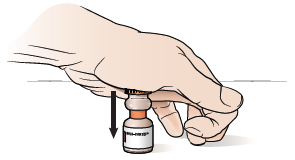
Figure 2. Pressing the cap
-
Turn the vial upside down a few times until the medication turns clear. That means it’s fully mixed.
- Don’t use the medication if it stays cloudy. Try another vial or call 911 if you don’t have one.
-
Take off the yellow tab on the top of the vial (see Figure 3). You’ll see an orange rubber stopper underneath.
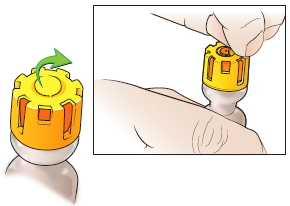
Figure 3. Removing the yellow disc
-
Clean the top of the vial with an alcohol wipe (see Figure 4). Let it dry.

Figure 4. Cleaning the top of the vial
- Pick up the syringe and take the cover off the needle.
-
Turn the vial upside down. Stick the needle into the middle of the orange rubber stopper (see Figure 5). Make sure the needle tip is in the liquid.
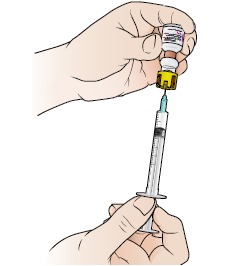
Figure 5. Drawing the Solu-Cortef into the syringe
- Gently pull the plunger back to fill the syringe with all the medication in the vial. Then, pull the needle out of the vial.
-
Check the syringe for air bubbles. If you see any, hold the syringe with the needle pointing up. Tap it with your fingers until the air bubbles rise to the top, near the needle (see Figure 6). Slowly push the plunger up to force the air bubbles out of the syringe. Be careful not to push out any medication.
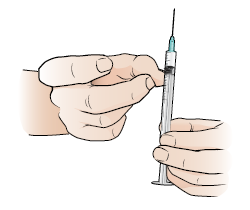
Figure 6. Tapping out air bubbles from syringe
- Put the cap back on the syringe. Place the syringe on a clean surface.
-
Use the other alcohol wipe to clean the injection site. The injection site is about halfway up your thigh towards the outer part of your thigh (see Figure 7).

Figure 7. The injection site
Give the Shot
- Pick up the syringe and take off the cap. Hold the syringe in your fist, making sure your thumb is not on the plunger.
- With your other hand, press down on your skin around the area where you’re giving yourself the injection.
-
Put the needle straight down into your thigh in one quick motion (see Figure 8). Your nurse will tell you how deep to insert the needle.
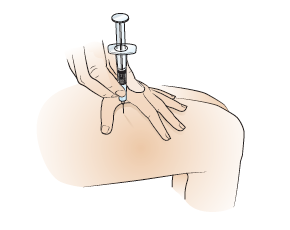
Figure 8. Putting the needle into your thigh
-
Move your thumb to the plunger. Slowly push down the plunger to inject the medication into your thigh (see Figure 9).
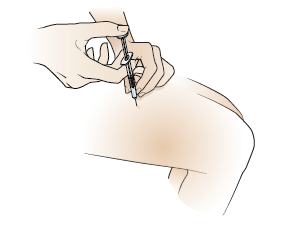
Figure 9. Pushing the plunger to inject the medication
- Keep the needle in your thigh for 10 seconds so the medication goes into your body. Then, pull it straight out and set it aside.
- Press down on you thigh with gauze for a few seconds. Cover the injection site with a bandage.
- Drop the syringe and needle into the sharps container.
Call 911 or have your caregiver take you to a nearby emergency room after giving yourself the injection. You may need more medical care.
Check your local health department’s instructions for how to safely throw away your sharps. For information about storing and disposing of sharps, read How to Store and Get Rid of Your Home Medical Sharps.
MedicAlert® Jewelry
You should also wear a MedicAlert bracelet or necklace stating that you have adrenal insufficiency. This way, if you’re ever seriously ill or hurt, medical professionals will know that you may need an emergency injection.
For more information, visit the MedicAlert website at www.medicalert.com. You can also call MedicAlert at 800-432-5378.
